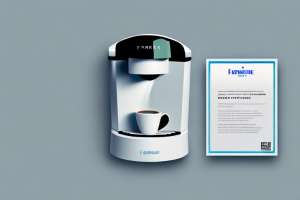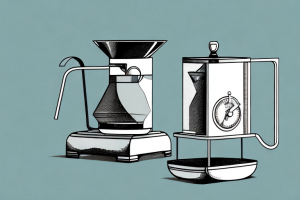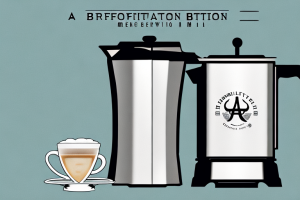Black And Decker Coffee Maker Clean

A black and decker coffee maker being cleaned
Coffee makers are integral part of the daily routine of coffee lovers around the world. Coffee, being one of the most consumed beverages, has become synonymous with our mornings. A well-functioning coffee maker is essential to ensure the perfect cup of coffee every time. To achieve that, it is crucial to keep your Black and Decker coffee maker clean. In this article, we will discuss why it’s crucial to clean your coffee maker regularly, the materials needed for cleaning, step-by-step guide, tips for maintaining your coffee maker, and much more.
Why it’s important to clean your coffee maker regularly
Keeping your coffee maker clean is significant for several reasons, including ensuring the quality and taste of your coffee, extending the lifespan of your machine, and preventing bacterial growth. A dirty coffee maker can make coffee taste unpleasant, even when using high-quality coffee beans. Hard water buildup can also affect the performance of your coffee maker. Cleaning your coffee machine regularly helps to remove all the accumulated debris, moisture, and bacterial growth, and your coffee machine will perform optimally.
Another reason to clean your coffee maker regularly is to avoid the buildup of mineral deposits. Hard water contains minerals such as calcium and magnesium, which can accumulate in your coffee maker over time. These mineral deposits can clog the machine’s pipes and affect the taste of your coffee. By cleaning your coffee maker regularly, you can prevent the buildup of mineral deposits and ensure that your coffee tastes fresh and delicious every time.
Cleaning your coffee maker regularly can also help to prevent mold growth. Moisture can accumulate in your coffee maker, providing the perfect environment for mold to grow. Mold can be harmful to your health, and it can also affect the taste of your coffee. By cleaning your coffee maker regularly and allowing it to dry completely between uses, you can prevent mold growth and ensure that your coffee is safe and delicious.
Materials needed for cleaning your Black and Decker coffee maker
To clean your Black and Decker coffee maker, you will need the following items:
- Vinegar or Descaling solution
- Water
- A clean rag
Before you begin cleaning your coffee maker, make sure to unplug it and let it cool down completely. This will prevent any accidents or burns from occurring during the cleaning process.
It is recommended to clean your coffee maker at least once a month to ensure that it continues to function properly and produce great-tasting coffee. Neglecting to clean your coffee maker can result in mineral buildup, which can affect the taste of your coffee and even cause damage to the machine over time.
Step-by-step guide to cleaning your Black and Decker coffee maker
Here is a guide on how to clean your Black and Decker coffee maker:
- Prepare the solution: Mix one part of vinegar or descaling solution with two parts of water. You can use a measuring cup to get the quantity right.
- Pour the solution into the water reservoir of your coffee maker.
- Run the coffee maker through one normal brewing cycle. Discard the solution after use.
- Fill the water reservoir with fresh water and run the machine through another brewing cycle to rinse.
- Repeat the rinsing process until the vinegar smell disappears.
- Once the rinsing process is complete, dry the coffee maker thoroughly.
It is recommended to clean your Black and Decker coffee maker at least once a month to ensure that it continues to function properly. Neglecting to clean your coffee maker can lead to a buildup of mineral deposits, which can affect the taste of your coffee and even cause damage to the machine over time. Additionally, if you notice any mold or mildew growing in your coffee maker, it is important to clean it immediately to prevent any health hazards.
Tips for maintaining your Black and Decker coffee maker
Here are some tips for maintaining your Black and Decker coffee maker for long-lasting performance:
- Always use filtered water to brew your coffee
- Clean your machine after every use.
- Descale your coffee maker as per the instructions provided yearly.
- Regularly replace the filters.
Additionally, it is important to avoid using harsh chemicals or abrasive materials when cleaning your coffee maker. Instead, use a mild soap and a soft cloth to wipe down the exterior and interior of the machine. It is also recommended to run a cycle of water through the machine before brewing your first pot of coffee to ensure that any cleaning residue is removed.
How often should you clean your coffee maker
The frequency of cleaning your coffee maker depends on how often you use it. It’s ideal to clean your coffee machine every month. However, if you use it more often, you may need to clean it more frequently.
It’s important to note that not cleaning your coffee maker regularly can lead to the buildup of mineral deposits and bacteria, which can affect the taste of your coffee and even make you sick. To clean your coffee maker, you can use a mixture of water and vinegar or a specialized cleaning solution. Be sure to follow the manufacturer’s instructions and rinse the machine thoroughly after cleaning.
Common mistakes to avoid when cleaning your coffee maker
Here are some common mistakes to avoid when cleaning your Black and Decker coffee maker:
- Do not run your coffee maker without water or the cleaning solution as it can damage the machine.
- Never put the coffee carafe in the dishwasher, as it may crack.
- Do not reuse filters to save money, as it affects the quality of the coffee
Additionally, it is important to clean your coffee maker regularly to prevent the buildup of mineral deposits and bacteria. To do this, mix equal parts of water and white vinegar and run it through the coffee maker. Then, run plain water through the machine to rinse it out. This should be done at least once a month, or more frequently if you use your coffee maker daily.
Alternative methods for cleaning your Black and Decker coffee maker
If you don’t have vinegar or descaling solution, you can use a lemon and water solution instead. The citric acid present in the lemon can help to dissolve the hard water buildup. Follow the same process as described in the step-by-step guide section.
Another alternative method for cleaning your Black and Decker coffee maker is to use baking soda and water. Baking soda is a natural cleaner and can help to remove any stubborn stains or buildup. Mix one tablespoon of baking soda with one cup of water and pour the solution into the water reservoir. Run the coffee maker through a brewing cycle and then rinse with clean water. Repeat the process if necessary.
How to remove stubborn stains from your coffee maker
If you have stubborn coffee stains on your coffee maker, you can use a mixture of baking soda and water. The baking soda works wonders in dissolving the stains and leaving your machine sparkling clean. Apply the mixture with a clean rag and wipe down the coffee maker. Rinse thoroughly with clean water.
Another effective way to remove stubborn coffee stains from your coffee maker is by using white vinegar. Mix equal parts of white vinegar and water and pour the solution into the water reservoir of your coffee maker. Turn on the machine and let it run through a full cycle. Once the cycle is complete, run another cycle with clean water to rinse out any remaining vinegar solution.
It’s important to regularly clean your coffee maker to prevent the buildup of stains and bacteria. You can use a specialized coffee maker cleaner or simply run a cycle with a mixture of water and vinegar once a month. Additionally, make sure to clean the carafe, filter basket, and any other removable parts after each use to keep your coffee maker in top condition.
The benefits of using a clean coffee maker
Using a clean coffee maker is crucial not just for the taste of your coffee, but for your health as well. A dirty coffee maker can lead to bacterial buildup which can adversely affect your health. A clean coffee maker ensures that there is no buildup of bacteria or mold, ensuring that you are drinking healthy coffee.
Another benefit of using a clean coffee maker is that it can extend the lifespan of your machine. When coffee oils and residue build up in the machine, it can cause clogs and damage to the internal components. Regular cleaning can prevent this and keep your coffee maker running smoothly for longer.
Cleaning your coffee maker can also improve the taste of your coffee. Over time, mineral deposits can accumulate in the machine, affecting the flavor of your coffee. By regularly cleaning your coffee maker, you can remove these deposits and ensure that your coffee tastes as good as possible.
Cleaning hacks for a sparkling clean Black and Decker coffee maker
You can keep your coffee maker sparkling clean with these simple hacks:
- Remove stubborn stains with vinegar or baking soda solution
- Use lemon juice to remove hard water stains
- Regularly wipe down the coffee maker and filter area to prevent buildup.
Additionally, it is important to clean the carafe and the water reservoir regularly. The carafe can be cleaned with warm soapy water and a soft sponge, while the water reservoir can be cleaned with a mixture of water and vinegar. It is also recommended to run a cycle of water and vinegar through the coffee maker every few months to remove any buildup and keep it functioning properly.
Troubleshooting common issues with your Black and Decker coffee maker
If you encounter any issues with your Black and Decker coffee maker, refer to the user manual. For issues that cannot be resolved, contact the customer service team for assistance.
Cleaning your Black and Decker coffee maker regularly is crucial for the perfect cup of coffee every time. Maintaining your coffee maker is essential for its longevity and performance. Use these simple tips and methods discussed above to keep your machine clean and functioning as it should.
One common issue that users may encounter with their Black and Decker coffee maker is a clogged filter. This can result in slow brewing or weak coffee. To fix this issue, remove the filter and rinse it thoroughly with hot water. If the filter is still clogged, try soaking it in a mixture of hot water and vinegar for 30 minutes before rinsing it again. Regularly replacing the filter can also prevent this issue from occurring.



